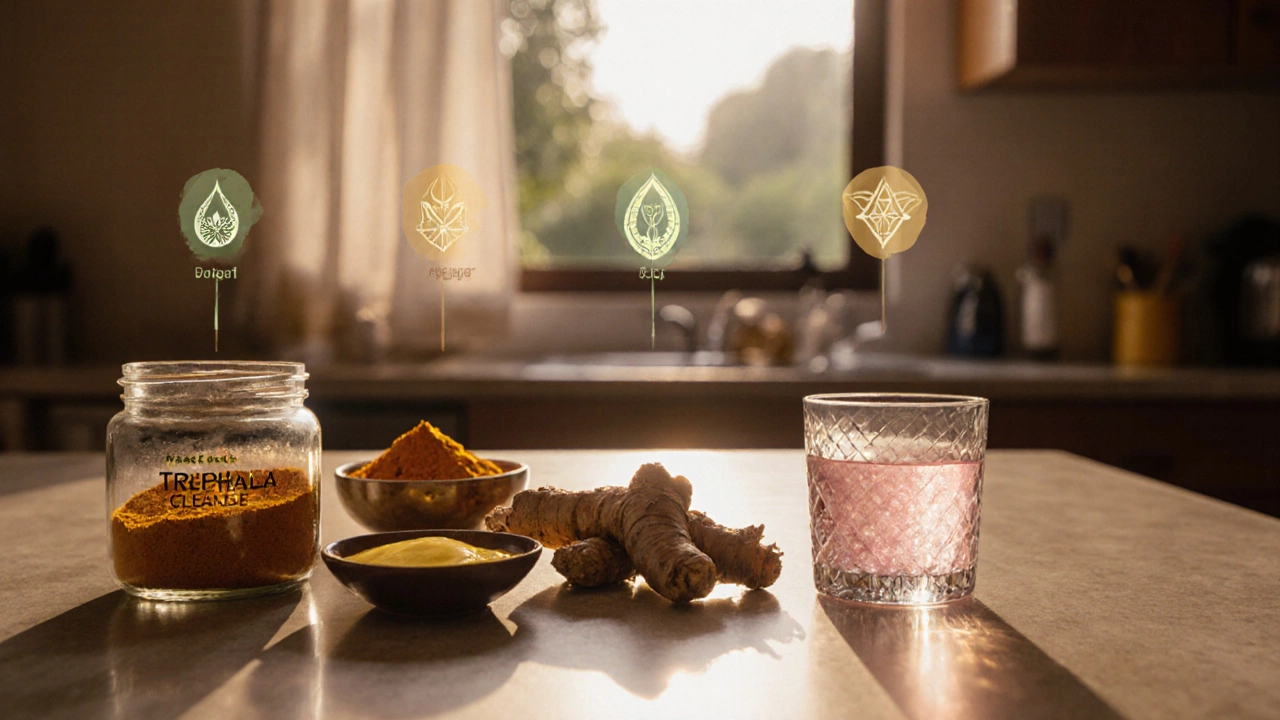Ayurvedic Cleanse Safety Checker
Check Your Personal Risk Factors
This tool helps you understand potential side effects based on your health conditions, medications, and herbs you're planning to use.
Risk Assessment Results
Specific Concerns:
When you hear Ayurvedic cleanse is a traditional detox program that uses herbs, diet changes, and therapeutic practices to balance the body’s doshas, you might think it’s all safe because it’s natural. The truth is a bit messier - the same herbs that help clear toxins can also stir up unwanted reactions if you’re not careful.
Ayurvedic cleanse side effects can range from mild stomach upset to more serious concerns like electrolyte imbalance. Knowing what to expect helps you decide whether to start a cleanse, how to prepare, and when to stop.
Why People Turn to an Ayurvedic Cleanse
Most seekers are looking for one of three things: a jump‑start to weight loss, relief from lingering digestion problems, or a way to reset their energy after a stressful season. Ayurvedic practitioners usually prescribe a cleanse based on your dominant dosha - Vata, Pitta, or Kapha - and recommend specific herbs, fasting periods, and body‑work like abhyanga (oil massage).
Common Types of Ayurvedic Cleanses
- Panchakarma - a multi‑day protocol that includes oil massages, steam therapy, and herbal enemas.
- Seasonal fasts that limit solid food to fruit, vegetable soups, or a single herb‑based drink.
- Herbal regimens centered around Triphala, a blend of three fruits known for gentle bowel cleansing.
Typical Ingredients and Their Intended Benefits
| Ingredient | Primary Purpose | Possible Side Effects |
|---|---|---|
| Triphala | Laxative, antioxidant | Loose stools, abdominal cramping |
| Turmeric | Anti‑inflammatory, liver support | Stomach irritation, gallstone aggravation |
| Ashwagandha | Adaptogen, stress relief | Drowsiness, lowered blood pressure |
| Ghee (clarified butter) | Lubricates digestive tract, boosts absorption | Weight gain if overused, dairy allergy flare |
| Mishri (rock sugar) | Gentle sweetener, soothing for throat | Blood sugar spikes, dental issues |
| Koshtha | Colon cleansing technique (herbal enemas) | Rectal irritation, electrolyte loss |

Major Categories of Side Effects
Even if you follow a reputable program, the body can react in several ways. Here’s what tends to pop up most often.
Gastrointestinal Issues
- Diarrhea or loose stools - common with Triphala, especially if you take a higher dose.
- Constipation - paradoxically, some people experience slowed transit when the diet is too low in fiber.
- Acid reflux - spiced herbal teas can trigger heartburn in sensitive stomachs.
Metabolic and Electrolyte Concerns
- Low blood sugar - fast‑acting carbs like Mishri can cause swings if you’re diabetic.
- Dehydration - prolonged fasting reduces fluid intake, leading to headache and dizziness.
- Electrolyte imbalance - enemas (Koshtha) can flush out potassium and sodium.
Hormonal and Blood Pressure Shifts
- Ashwagandha may lower blood pressure; combine it with medication and you could feel light‑headed.
- Some herbs stimulate thyroid activity, which can aggravate hyperthyroidism.
Allergic Reactions and Skin Flare‑Ups
- Turmeric’s curcumin can cause contact dermatitis for people with a sensitivity.
- Ghee may trigger a dairy allergy or worsen eczema in a few users.
Interaction with Prescription Drugs
Because Ayurvedic herbs influence liver enzymes, they can either speed up or slow down how medicines are metabolized. For example, Triphala may enhance the effect of blood thinners, raising bleeding risk.
Who Should Avoid an Ayurvedic Cleanse
If any of the following apply to you, pause before you start:
- Pregnant or breastfeeding - many herbs can affect the fetus or infant.
- Chronic kidney or liver disease - the detox process adds extra strain.
- Recent surgery or major injury - fasting can impair wound healing.
- Medications that affect blood sugar, blood pressure, or clotting - consult a doctor first.
Tips to Minimize Risks
- Get a personalized assessment from a certified Ayurvedic practitioner; generic online plans miss your unique dosha balance.
- Start with a milder protocol - a three‑day Triphala regimen before attempting a full Panchakarma.
- Stay hydrated: sip warm water with a pinch of pink Himalayan salt to keep electrolytes stable.
- Monitor blood pressure and blood sugar daily if you have pre‑existing conditions.
- End the cleanse gradually; reintroduce solid foods over 2‑3 days to avoid rebound digestion issues.

When to Seek Medical Help
Even though Ayurveda emphasizes natural healing, certain symptoms signal you need a doctor’s eye:
- Persistent vomiting or diarrhea lasting more than 48hours.
- Severe abdominal pain that doesn’t improve with rest.
- Dizziness, fainting, or heart palpitations during the cleanse.
- Rash, swelling, or breathing difficulty after taking an herb.
Bottom Line
Ayurvedic cleanses can be a powerful reset, but they’re not risk‑free. Understanding the possible side effects, matching the protocol to your constitution, and keeping a medical safety net in place will let you enjoy the benefits without the unpleasant surprises.
Frequently Asked Questions
Can I do an Ayurvedic cleanse if I have diabetes?
Yes, but only with a doctor’s approval. Choose a low‑sugar protocol, avoid excessive Mishri, and check blood glucose several times a day.
How long should a typical Panchakarma program last?
Traditional Panchakarma spans 5‑7 days, though many clinics offer a shortened 3‑day version for beginners.
Is Triphala safe for everyone?
It’s generally gentle, but people with low blood pressure or those on anticoagulants should start with a half‑dose and monitor for any bruising or dizziness.
What should I eat after completing a cleanse?
Begin with warm, cooked vegetables, easy-to-digest grains like rice or quinoa, and a small amount of ghee to soothe the gut. Add proteins gradually over the next couple of days.
Can I combine an Ayurvedic cleanse with Western supplements?
Mixing can be okay, but watch for overlapping ingredients. For instance, a multivitamin with high vitaminC plus a Turmeric supplement might increase stomach acidity.

 Which State Has the Cheapest IVF in the U.S.?
Which State Has the Cheapest IVF in the U.S.?
 Understanding Knee Pain: When is Knee Replacement Necessary?
Understanding Knee Pain: When is Knee Replacement Necessary?
 Is Medical Tourism Safe in Mexico? What You Need to Know Before You Go
Is Medical Tourism Safe in Mexico? What You Need to Know Before You Go
 What Herbs Should You Not Mix Together? Avoiding Dangerous Herbal Combos
What Herbs Should You Not Mix Together? Avoiding Dangerous Herbal Combos
 Navigating Boundaries: Sharing Wisely with Your Therapist
Navigating Boundaries: Sharing Wisely with Your Therapist